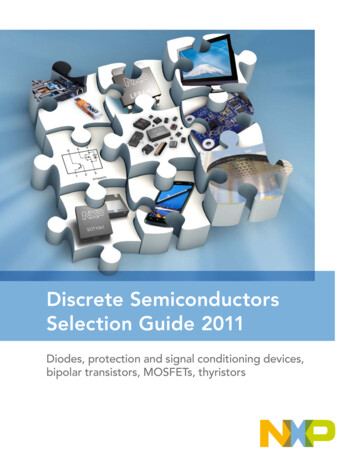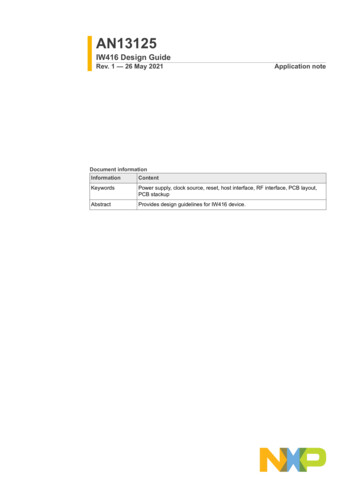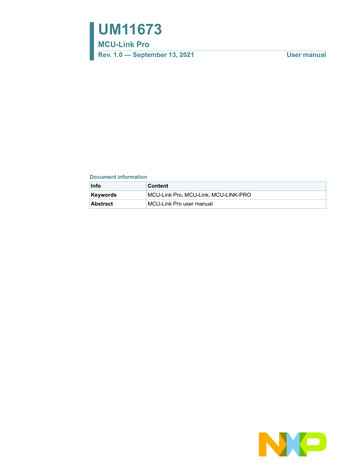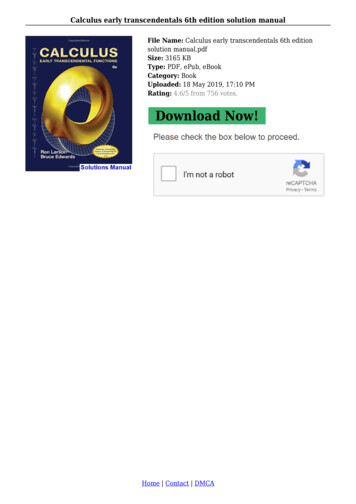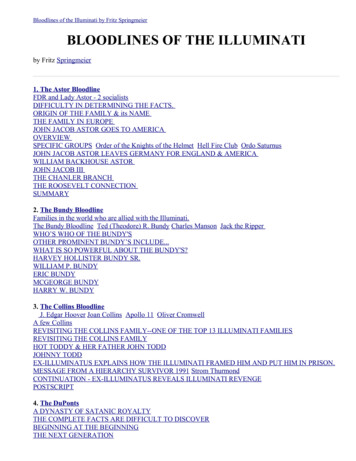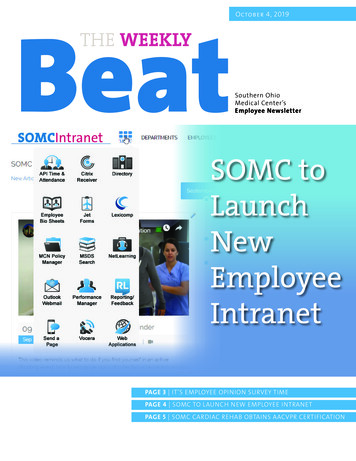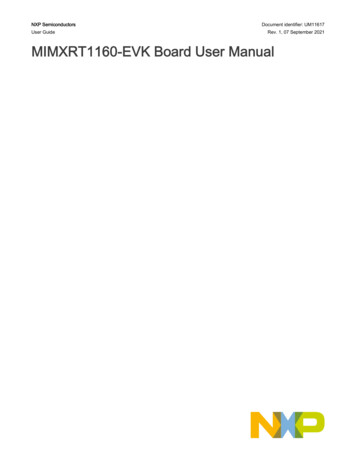
Transcription
RF MANUAL 20 EDITIONTHApplication and design manual for Smart Antenna SolutionsMay 2017
RF integration without compromiseAt NXP, we are committed to ensuring you have the bestmobile connection at all times.With more than 3 Billion consumers online and over 50 Billion connecteddevices, the demand for always-on, always-connected devices continuesto surge. With access to the internet by mobile device increasing by morethan 200% every year, mobile device manufacturers and infrastructurenetwork vendors now face unprecedented challenges to deliver the highperformance voice and data services for all the downloading, streamingand cloud based services we have come to expect.RF front-ends are becoming increasingly complex with the rapiddeployment of LTE underway. More antennas are needed as well assupport for an ever increasing number of cellular frequency bands. Justa few years ago only a handful of bands would need to be supported,whereas now 30 bands are supported. To address all these RFchallenges, while simultaneously achieving miniaturization and costreduction, a new approach is needed.The 20th edition of the RF Manual provides you with a comprehensiveoverview of our Smart Antenna Solutions with the highest level ofintegration without compromise; High performance, fully integratedcombinations of multiple RF functions close to the antennas, deliveringthe highest, flawless performance, reliability, flexibility, quality or costof-ownership.2NXP Semiconductors RF Manual 20th edition
How to use the RF ManualThis document is a resource that lets you explore our RF portfolio.Chapter 1 – Products by applicationDiscusses trends and requirements for particular applications,and lists the products we recommend for target systems.Chapter 5 – Replacement for discontinued partsProvides an overview of recently discontinued parts and their(close) replacements from NXP.Chapter 2 – NXP technologiesDescribes the special process and packaging technologies thatposition us as a leader in RF.Chapter 6 – Packaging informationGives an overview of the packages and the marking codes.Chapter 3 – Products by categoryPresents products by function, with detailed specs for easycomparison.Chapter 7 – Products by NXP type numberGives all the NXP type numbers mentioned in this manual, inalphanumeric order, so you can quickly find the details for aspecific product.Chapter 4 – Design resourcesSummarizes the design-support resources that help make iteasier to work with our products and reduce time-to-market.RF Manual web pagewww.nxp.com/rfmanualNXP Semiconductors RF Manual 20th edition3
Contents1Products by application1.11.2New products 8Wireless connectivity mobile & wearable 91.2.1 WLAN for mobile & wearable application 91.2.2 LTE LNA 101.2.3 GPS for smartphones, tablets and wearables 111.3Wireless communication infrastructure 141.3.1 Base stations (all cellular standards and frequencies) 141.3.2 Repeater 161.3.3 Small cells 17Broadband communication infrastructure and TV 181.4.1 WLAN: access points and routers, fixed consumer electronics 181.4.2 Cable modem and set-top boxes based on DOCSIS 3.0 & 3.1 191.4.3 Network Interface Module (NIM) for TV reception 201.4.4 Optical mini- and midi-node line-up 211.4.5 Broadband line extenders 22Satellite 231.5.1 Satellite outdoor unit, QUAD LNB with integrated mixer/oscillator/downconverter/switch matrix 231.5.2 Satellite outdoor unit, twin LNB with integrated mixer/oscillator/downconverter 241.5.3 Satellite outdoor unit, twin LNB with discrete components 251.5.4 Satellite multi-switch box - 4 x 4 (up to 16 x 16)/DiSEqC/SMATV 261.5.5 VSAT with integrated mixer/oscillator/downconverter 27Generic RF front-end for IOT 29Automotive 311.7.1 Remote Keyless Entry (RKE), RF generic front-end with dedicated antenna for reception and transmission 311.7.2 Tire-pressure monitoring system 321.7.3 SDARS and HD radio 331.41.51.61.72Technologies8352.1 Looking for a leader in SiGe:C? You just found us! 352.2 High-performance, small-size packaging 363Products by function393.1RF ICs 393.1.1 RF MMIC amplifiers and mixers 393.1.2 Wideband amplifiers 423.1.3 Variable gain and discrete step amplifiers 433.1.4 Power amplifiers 443.1.5 Modulators, mixers, PLL and downconverters 443.2 RF Bipolar transistors 463.2.1 Wideband transistors 463.3 RF diodes 493.3.1 Varicap diodes 493.3.2 PIN diodes 503.3.3 Band-switch diodes 523.4 RF MOS transistors 533.4.1 JFETs 533.4.2 MOSFETs 544NXP Semiconductors RF Manual 20th edition
4Design support574.1Explore NXP's RF portfolio 574.2 Product selection on NXP.com 574.3 Product evaluation 574.4Additional design-in support 584.5 Application notes 584.6 Simulation models 645Replacement for discontinued parts 685.1Cross-references: NXP discontinued types versus NXP replacement types 686Packing and packaging information 706.1 Packing quantities per package with relevant ordering codes 706.2 Marking codes 717Product index 73NXP Semiconductors RF Manual 20th edition5
LEADING IN ADVANCEDRF SOLUTIONSWe're trusted by the world's top businesses. That's why 9 outof the top 10 smartphone OEMs use NXP GPS LNAs.6NXP Semiconductors RF Manual 20th edition
In Focus: BL SAS new type naming conventionCMYCMMYCYCMYK3. The last two numerical digits are likea serial number used e.g. to indicaterevision history. LTEWLANGPSBTSMMWRDRA L M H U C X K V W Y AL NUMBRICTIONFUNLTEWireless LANGPSBasestation / Small CellmmWaveRadarALL0.7 —— 11.4 —— 22 —— 2.83 —— 44 —— 88 —— 1212 —— 4040 —— 7575 —— 100Multi frequencyProductsby application6789PassiveLNATo be definedLNA BypassMulti LNA SWLNA, DSA, VGA / Multi LNA,SW, MIPI, MUXMPAFEICLNA, VCO, PLL, MIX, IFABFLTE1001MCMARKETENCY INGQUHz4. As the frequency is one of the mostimportant aspects in the smart antennadomain, the next alpha digit indicatesfrequency of the part, like H for 2 – 2.8GHz, K for 12 - 40 GHz, etc, see below. FRE2. The next two numerical digits identify theproduct’s function, like LNA, MPA, etc,see picture.012345ER1. The first set of letters in the new partnumbers represent the market: LTE,WLAN, GPS, BTS for Basestation andsmall cell, MMW for millimeter Wave, andRDR for our line of Radar products.SEAs one of the industry’s leading technology company, NXP is constantly looking for ways to improve our products and ouraccessibility to those evaluating our products. One way that we’ve improved accessibility is by creating a new naming conventionfor the Smart Antenna Solutions portfolio. The parts you’re already ordering will not change. However, new part numbers willfollow a simple and consistent structure to make it easier for you to identify and order in the future.CKAGEPAC CSPLearn more on SharePoint: BL SAS – Marketing & Sales – Marketing Public Documents5. And lastly, if the part comes in a CSP package, it will be indicated by the letter C.To get used to this new type naming methodology more quickly, we selected our 55 most important products and ‘translated’them according the new naming convention. You will see them often be communicated next to each other (dual branding). We’reconfident this will not only be easier to understand but will make ordering simple.New NameCurrent TypeNew NameCurrent TypeNew NameCurrent 01HBGS8C5BGS8H5WLAN7001CWLAN7002CBGF8458BGF8658NXP Semiconductors RF Manual 20th edition7
1. Products by applicationNXP RF product catalog:http://www.nxp.com/rf1.1New productsDEV in DEVelopmentCQS Customer Qualification SamplesRFS Released For SupplyApplication/descriptionExpectedstatusJune 2015PlannedreleaseSectionGPS1301MGPS1401MGPS LNA, low current 1 mAGPS LNA, small package (0.8 x 0.8 1HLTE3301CLTE3301ULTE3401LLTE LNA with bypass from 0.7 to 1 GHz, 0.7 dB NF, 15 dB gainLTE LNA with bypass from 1.5 to 2.7 GHz, 0.8 dB NF, 14 dB gainLTE LNA with bypass from 3.4 to 3.8 GHz, 1.0 dB NF, 16 dB gainLTE LNA with bypass from 5.1 to 5.95 GHz, 1.25 dB NF, 15 dB gainLTE LNA with bypass from 0.7 to 1 GHz, 0.85 dB NF, 18 dB N3101HWLAN3101CWLAN7001C2.4 GHz LNA for WLAN, 802.11b/g/n5 GHz LNA for WLAN, 802.11a/n/ac2.4 GHz LNA for WLAN, 802.11b/g/n, small package5 GHz LNA for WLAN, 802.11a/n/ac, small package5 GHz FEIC for WLAN, dreleasedQ2-20173.1.13.1.13.1.13.1.13.1.1Variable gain high-linearity LNA 2.3-2.6 GHz, 1.1 dB NFHigh-linearity LNA with bypass 0.3-1.5 GHz, 1.1 dB NFHigh-linearity LNA with bypass 1.5-2.5 GHz, 1.3 dB NFHigh-linearity LNA with bypass 2.5-4.0 GHz, 1.6 dB 13.1.13.1.13.1.1DOCSIS 3.1 upstream amplifierRFSreleased3.1.3TypeNew nameNEW: SiGe:C LNAs (for e.g. GPS)BGU8103BGU8309NEW: LNAs for LTEBGS8L5BGS8M5BGS8C5BGS8U5NEW: LNAs for WLANBGS8324BGS8358BGS8424BGS8458BGF8458NEW: LNAs for wireless 62BTS3001MBGU8063BTS3001HNEW: DOCSIS Cable ModemBGA31318-NXP Semiconductors RF Manual 20th edition
1.2Wireless connectivity mobile & wearable1.2.1WLAN for mobile & wearable applicationWLANRFBBBProductsby applicationApplication diagram for WLAN2 GHzBB5 GHzBaaa-007042Recommended productsFunctionProductgain (dB)NF (dB)IIP3 (dB)PackageTypeNew name2.4 GHz LNA switchMMIC16 @ 8.3 mA2.07SOT1261BGS8324WLAN3001H5 GHz LNA switchMMIC15.5 @ 8.4 mA2.06SOT1261BGS8424WLAN3101H12.5 @ 9.5 mA2.310SOT1260BGS8358WLAN3001C13.5 @ 10.7 mA2.49SOT1234BGS8458WLAN3101CPout (dB)FunctionProductgain (dB)NF (dB)5 GHz FEICMMIC14 @ 8 mA2.3PackageTypeNew nameSOT1436BGF8458WLAN7001CFor the complete product selection please see section 3.1.1Product highlight:WLAN LNAs plus switch BGS8424 [WLAN3101H]and BGS8458 [WLAN3101C]These fully integrated LNAs plus switch are optimized for mobileIEEE 802.11b/g/n/ac WLAN applications in the 2.4 and 5 GHz bands.Manufactured in our high-performance QUBiC4 GEN8 technology,they combine best-in-class gain, noise figure, linearity for the LNAand an integrated RX/TX(/BT) switch with the process stability andruggedness that SiGe technology is known for.Features Fully integrated, high-performance LNA and switch (no externalmatching or DC blocking required) LNA Noise Figure (NF) of 2.0 dB (2.4 GHz) and 2.4 dB (5 GHz), withlow current consumption of 8.4 resp. 10.7 mA Integrated TX-RX(-BT) switch with low losses (0.7 dB) Low bypass current of 8 resp. 4 μA Single-supply operation covering full Li-ion battery range from 2.7to 5.25 V Small QFN-style package (1.5 x 1.5 x 0.3 resp. 1.2 x 1.4 x 0.3 mm,0.4 mm pitch)NXP Semiconductors RF Manual 20th edition9
1.2.2LTE LNAWhile LTE/4G offers consumers much higher data rates (up to 300 Mbits/s) compared to UMTS/3G, LTE smartphones are morecomplex because they need more antennas, are used for multiple cellular and connectivity frequencies, and require additionalswitches and duplexers. BGS8x2 and BGU8x1 LTE LNAs increase the receive sensitivity of LTE main and diversity receivers byoffering system-optimized gain, low noise figure, and high third-order linearity. As a result, LTE smartphone users enjoy higher andmore consistent data rates. These features also mean RF designers have more options, as they can amplify the LTE signal closeto the antenna and decrease line losses - something that is especially important for large tablet and combination phone/tablet("phablet") form factors. The BGU8x1 and BGS8x2 LTE LNAs are available for Low (BGU8L1, BGS8L2), Mid (BGU8M1, BGS8M2)and High (BGU8H1, BGS8H2) cellular bands. The difference between the BGS8x2 and the BGU8x1 is that the BGS8x2 has a switchto bypass the LNA. This is beneficial when high RF signal levels are available at the input and there is no need for additional gain,because the LNA can be bypassed and switched off to lower the power consumption.Application diagram of an LTE LNA in a mobile itchandDiversityAntennafiltersRecommended productsFunctionLNALNA bypassProductMMICMMICFrequency (MHz)Gain (dB)NF (dB)728 - 9601805 - 22002300 - 2690728 - 9601805 - 22002300 - 2690703 - 9601425-26903400 - 38005150 - .90.850.851.00.70.751.01.250.85PackageTypeNew ULTE3301CLTE3401L* also available in CSP package, contact NXP for detailed information on specificationsFor the complete product selection please see section 3.1.1Product highlight:LTE LNAs with bypass BGS8x5 [LTE3301x]The BGS8x5 delivers a full range of LTE LNAs covering the fullLTE(-U) frequency range from 700 MHz up 6 GHz with products,each optimized for a sub-range of frequencies. The BGS8x5 canbe applied in both primary and diversity path of LTE receivers todeliver better sensitivity under severe co-existence conditions (e.g.simultaneous cellular TX in FDD systems). The bypass switch allowsto switch off the LNA under higher input signal conditions, therebyreducing the current consumption to less than 1 uA. The BGS8x2requires only one external matching inductor.10NXP Semiconductors RF Manual 20th editionFeatures Smallest 6-pin leadless package (1.1 mm x 0.7 mm x 0.37mm) Cover all bands with a Low (from 700 to 960 MHz), High (from 1425to 2700 MHz), Ultra High (from 3400 to 3800 MHz) and C-band (from5150 to 5850 MHz) Noise figure (NF) between 0.7 and 1.25 dB at a gain between 13 and15.5 dB Current consumption of 4.5 mA in gain mode, 1 uA in bypass mode High linearity (1 dB compression point and IIP3) Supply voltage from 1.5 to 3.1 V Require only one input matching inductor
GPS for smartphones, tablets and wearablesBGU600x/700x/800x LNAs are designed to improve the linearity, noise figure, and reception of GPS signals, including GloNassand Compass, while offering the smallest footprint in the market. As the industry’s first GPS LNAs to dynamically suppress strongcellular, Bluetooth, and WLAN transmit signals, the NXP BGU600x/700x/800x series offers the best reception for weakGPS signals, delivering an improvement of 10 dB or better IP3 under -40 to -20 dBm jamming conditions, while the noise figureremains below 1 dB. Requiring only one external component, the BGU600x/700x/800x LNAs save up to 70% in PCB size and10% in component cost.GPS is a standard feature in a wide range of consumer products, from smartphones, wearables, and tablets to digital still cameras,watches, electric cars, and more. GPS signal power levels are weak and below the noise floor at -155 dBm. In many of theseproducts, especially smartphones and tablets, strong transmitters such as Bluetooth, WLAN, and cellular can drive the GPS LNAinto compression. When the GPS LNA is in compression, it has lower gain, which causes poor GPS reception; it also generatesinter-modulation products and harmonics from the transmitter signals, capable of overpowering weak signals and leading toloss of GPS reception.The BGU600x/700x/800x series use adaptive biasing to immediately detect any output power from jammers, and compensateby temporarily increasing the current. As a result, optimal GPS signal reception is maintained for as long as possible. Each devicein the BGU700x/800x series requires only one input-matching inductor and an optional one supply decoupling capacitor tocomplete the design. This creates a very compact design and lowers the bill of materials.Application diagram of a GNSS LNA with pre- and post-SAWs and notches, implemented as discretes, for 788 MHz (LTE)and 2.4 GHz (WLAN) suppression2.4 GHz notch (WLAN, bluetooth)788 MHz notch (LTE)VCCC1VenL1GNSSLNARF outSAWSAWESD protection SAWto GNSS chipsetaaa-007041Product highlight:GPS LNA in diamond package BGU8309 [GPS1401M]The BGU8309 [GPS1401M] has all the features of its predecessorsput into smaller diamond shaped package. It features adaptive biasingto have optimal linearity versus current consumption performance inco-existence scenarios with radios in mobile phones. In nominal,non-jamming conditions it delivers 17dB gain at a noise figure of0.7 dB. The BGU8309 requires only one external matching inductor.Features Smallest 5-pin leadless package (0.8 x 0.8 x 0.35 mm) Covers full GNSS L1 band, from 1559 to 1610 MHz Noise figure 0.7 dB at a gain of 17 dB High 1 dB compression point of -9 dBm and out-of-band IP3i of 5 dBm Supply voltage 1.5 to 3.1 V, supply current 3.6 mA Power-down mode current consumption 1 uA Integrated, temperature-stabilized bias for easy designNXP Semiconductors RF Manual 20th edition11Productsby application1.2.3
Recommended productsFunctionProductvalue LNAmid end LNAMMIChigh end LNAIcc (mA)Gain (dB)NF (dB)PackageType5.217.50.85SOT886BGU6005New BGU8309low current LNA1.217.50.8SOT1232BGU8103*GPS1301Mautomotive 50.85SOT886BGU7008GPS1104M* also available in CSP package, contact NXP for detailed information on specificationsFor the complete product selection please see section 3.1.1In wearable health and fitness applications like smart watches, low current is critical, but linearity requirements can be relaxedsince the only relevant on-board jammers are Bluetooth and 2.4 GHz WLAN. For these low-current applications, NXP offers theBGU8010, which uses 3 mA of current and has a gain of 16 dB, the BGU8020, which uses 2 mA of current and has a gain of 16.5 dB,and the BGU8103, which uses 1.2 mA of current and has a gain of 17 dB.Application diagram of wearable health and fitness device, showing the input-match inductor (L1) and a post-SAWVen VccL1Post-SAWGPSReceiver ICThis application consists of the input match inductor L1 and a post SAW. Because no strong jammer signals are present,a pre-SAW is unnecessary.Product highlight:Low-current GPS LNA BGU8103[GPS1301M]Designed for extremely low power consumption, the BGU8103delivers optimal performance even when exposed to jammers fromcoexisting cellular and connectivity transmitters.12NXP Semiconductors RF Manual 20th editionFeatures Covers full GNSS L1 band, from 1559 to 1610 MHz Noise figure (NF) 0.85 dB Gain 17.3 dB Input 1 dB compression point of -16 dBm Out-of-band IP3i of -8 dBm Supply voltage 1.5 to 3.1 V Optimized performance at low supply current of 1.2 mA Power-down mode current consumption 1 μA
Productsby applicationENHANCING RFPERFORMANCENXP is committed to providing best-in-class RF solutionsthat help you reach new levels of performance fora smarter world.NXP Semiconductors RF Manual 20th edition13
1.3Wireless communication infrastructur1.3.1Base stations (all cellular standards and frequencies)RF components for transmit line-ups and receive chainsAs a global leader in RF technology and component design, NXP Semiconductors offers a complete portfolio of RF products,from low- to medium-power signal conditioning, that delivers advanced performance and helps simplify your design and thedevelopment process. Our solutions range from discretes and amplifiers (LNA, VGA, MPA) to mixers/oscillators.Application diagram of base station showing Tx, Rx, and Tx feedback functionsDPDCFRDUCDDCPower AmplifierDVGA R F-BPPLLVCODualDAC0HPA90TransmitterQIF-S AWJEDECIFMPADVGA Mixer LOTower (JEDEC) InterfaceOBS AI / CPR IDigital BasebandJEDEC InterfaceIQ-ModulatorIJEDEC InterfaceR F-S AWLNA VGARxDualADCBP or LPDualDVGAIF-S AWDualMixerPLLVCOLNATX / R X1µCR X2Filter UnitLNA VGAClockGeneratorJitter CleanerTx functions are in the upper region, Rx in the lower, and Tx feedback in the middle.Product highlight:Base-station LNAs with ultra-lownoise BGU805x [BTS1001x]The BGU8051, BGU8052, and BGU8053 SiGe:C BiCMOS LNAs aredesigned to support high-performance communications systems from300 up to 6000 MHz. Key enablers of maintaining sensitivity, even inadverse signal conditions, are high linearity (37 dB OIP3), ultra-lownoise figures (e.g. 0.4 dB), and wideband S11 20 dB behavior. Theseultra-low noise amplifiers enable 2G/3G/4G macro and micro basestation performance at unsurpassed value.14NXP Semiconductors RF Manual 20th editionFeatures Three versions to cover low frequency (300 – 1500 MHz), midfrequency (1500 – 2500 MHz) and high frequency (2500 – 6000 MHz)ranges Very low Noise Figure 0.43 – 0.57 dB at a gain of 18 dB Very high linearity (1
Chapter 5 - Replacement for discontinued parts Provides an overview of recently discontinued parts and their (close) replacements from NXP. Chapter 6 - Packaging information Gives an overview of the packages and the marking codes. Chapter 7 - Products by NXP type number Gives all the NXP type numbers mentioned in this manual, in

